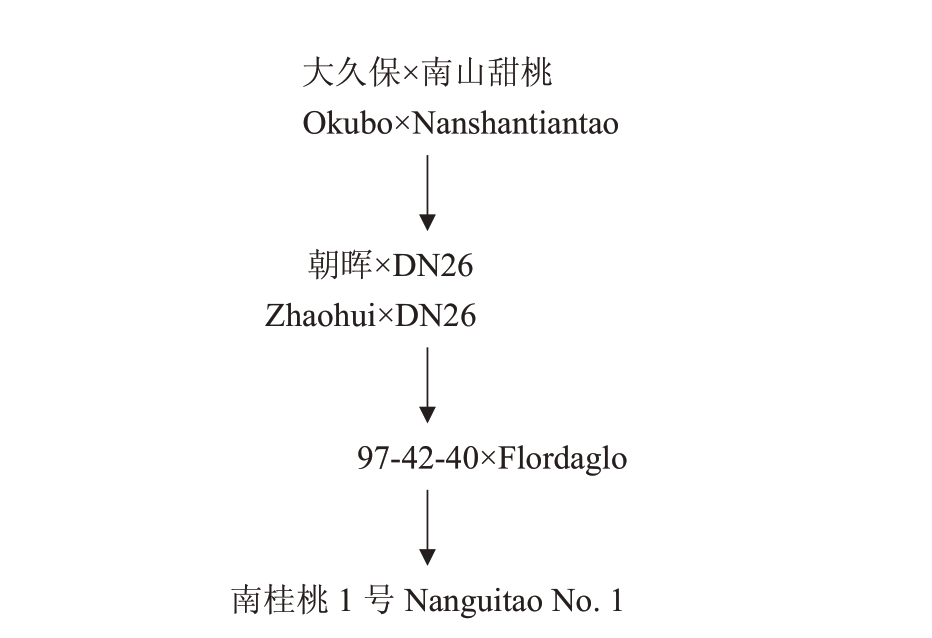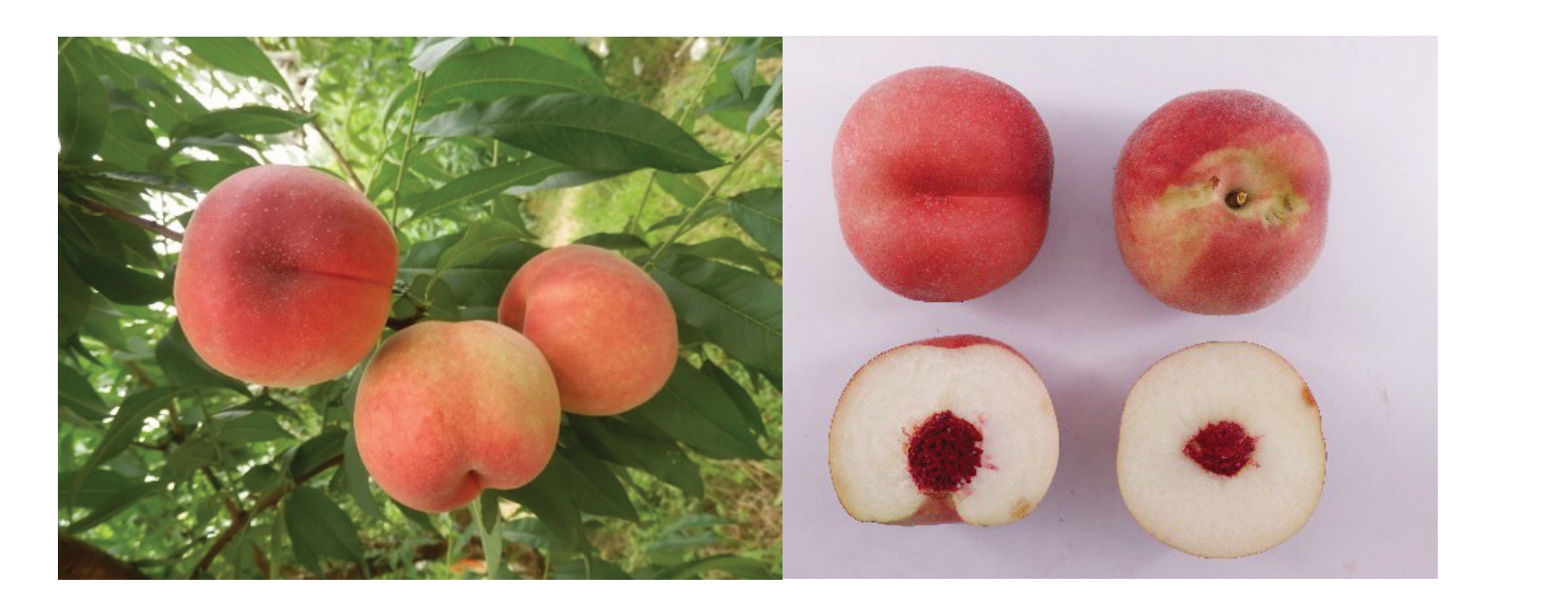需冷量是打破落叶果树自然休眠所需的有效低温时数,只有满足低温需求量,果树才能正常开花结果。我国自20 世纪80 年代末期开始进行桃品种需冷量评价[1],之后开展了遗传特性、新品种选育等研究[2]。近年南方低纬度地区桃树种植热情高涨,但所用品种多为常规中、高需冷量品种,由于冷量不充足,出现了开花不整齐、产量低等现象,制约了南方桃产业的发展;北方设施栽培品种也以露地早熟桃和油桃为主,为了抢早上市,大多采用提前扣棚、使用植物生长调节剂等措施,导致出现果顶尖凸、裂核、风味品质差等现象,严重影响了设施桃的市场价值。因此,培育需冷量低、果实品质优的桃品种,对扩大桃栽培南限和北方设施促早栽培具有重要意义。江苏省农业科学院以南山甜桃[3]、Flordaglo[4]等低需冷量种质为亲本,与优质栽培品种杂交,开启了低需冷量桃新品种选育研究。
1 选育经过
2004 年春以中熟水蜜桃优系97-42-40 为母本、美国低需冷量桃品种Flordaglo 为父本(图1),进行杂交授粉。7 月上旬采收杂交果实95 个,培育获得杂种实生苗79株;2005年春定植于江苏省农业科学院桃育种圃,株行距1 m×4 m,按照常规栽培措施进行日常管理,2007年杂种单株开花结果。经过连续3 a(年)的观察,单株XNN6-6 开花早,有花粉,果形端正,外观漂亮,风味甜(父本Flordaglo 风味酸),2009年选为优良单株,同年秋季在溧水基地进行高接。2011 年春向广西特色作物研究院提供接穗,2014年在桂林结果,2018年在百色的靖西结果。经连续多年多点的观察比较,该品种综合性状优良、表现稳定。花期较对照品种霞晖5 号提早10 d 左右,成熟期较霞晖5 号推迟1 周左右。采用0~7.2 ℃模型[5]测试,需冷量在200 h左右。2022年8月获得农业农村部植物新品种权证书,定名为南桂桃1号(图2)。

图1 南桂桃1 号的系谱关系
Fig.1 The pedigree of low chilling peach cultivar
Nanguitao No.1

图2 低需冷量桃新品种南桂桃1 号
Fig.2 A new low chilling peach cultivar Nanguitao No.1
2 主要性状
2.1 植物学特征
树势偏旺,树姿半开张。1 年生新梢向阳面紫红色,节间长度偏长,平均为2.93 cm。叶片长16.93 cm,宽4.50 cm,叶柄长0.97 cm,长椭圆披针形,绿色;叶柄蜜腺肾形,4~6个,多为4个;叶片先端渐尖,叶基部楔形,叶缘圆锯齿状。花为蔷薇型,花冠粉色。柱头与花药位置等高,萼筒内壁绿黄色,有花粉。
2.2 果实主要经济性状
果实扁圆形,果顶稍凹陷,缝合线浅,两半部对称,成熟度较一致。平均单果质量233 g,大果质量454 g。果皮底色白色,果面大部分着红色;果皮中厚、茸毛中等,梗洼中深。果肉白色,近核处有少量红色素,硬溶质,汁液中等,纤维少,风味甜,鲜食品质优。可溶性固形物含量(w,后同)为12.4%,可滴定酸含量为0.24%。半离核,核小(表1)。
表1 南桂桃1 号与其亲本和霞晖5 号的比较
Table 1 Comparisons of Nanguitao No.1 and parent and Xiahui No.5

注:“-”表示未测定可滴定酸含量。
Note:“-”indicates that titratable acid content was not detected.
品种Cultivar南桂桃1号Nanguitao No.1霞晖5号Xiahui No.5 Flordaglo平均单果质量Average fruit mass/g 233.0 w(可溶性固形物)Soluble solids content/%12.4盛花期Full bloom date 2月下旬至3月上旬Late Feb.to Early Mar.3月中旬Mid Mar.2月下旬至3月上旬Late Feb.to Early Mar.3月上旬Early Mar.果形Fruit shape扁圆Oblate圆Round扁圆Oblate圆Round w(可滴定酸)Titratable acid content/%0.24 178.0 12.7 0.15 156.0 10.5 0.44 97-42-40 199.9 11.1-肉质Flesh texture硬溶质Hard melting软溶质Soft melting硬溶质Hard melting硬溶质Hard melting风味Flavor甜Sweet甜Sweet酸Sour甜Sweet花粉育性Pollen fertility可育Fertile可育Fertile可育Fertile不稔Sterile
2.3 生长结果习性
南桂桃1号生长势较强,易成花,花芽起始节位第2~4 节,以复花芽为主。6 年生树徒长性果枝、长果枝、中果枝、短果枝、花束状果枝比例为3.29%、34.73%、20.96%、24.85%、16.17%,各类果枝均结果良好,自花可以结实,花期天气晴好的情况下,自然授粉坐果率达60%。早果丰产,1年生成苗种植第2年即可开花结果,第4 年进入盛果期,每666.7 m2产量控制在1500 kg左右。
2.4 物候期
该品种物候期偏早,在南京地区2月上旬萌芽,2月下旬至3月上旬盛花,花期持续7 d左右,主要与当时的气温相关;7月上中旬果实成熟;11月中旬开始落叶,12 月上旬落叶终止,全年生育期约290 d。在广西壮族自治区桂林市2月中旬盛花,6月中旬成熟;在百色的靖西,1月中旬盛花,5月底6月初果实成熟。
2.5 抗逆性及栽培适应性
南桂桃1号在江苏、广西均生长良好,至今未发现有特别病虫危害。2021年早春温度偏高,萌芽开花提前,2 月底温度下降并伴随降雨,南桂桃1 号出现少量缩叶病,之后随着温度的回升,新叶恢复正常。通过对6 年生树体流胶发生情况的田间观察,所调查植株均有流胶,发病等级为2~3级,属于中等抗性[6]。在广西产区,附近种植柑橘的桃园存在橘小实蝇危害现象。
3 栽培技术要点
3.1 定植建园
低需冷量品种生长期长、树体生长量大,不宜采用密植栽培模式。建议平地行距5 m,株距自然开心形3~4 m、两主枝Y形2.5~3.0 m;丘陵山地根据地形地貌而定。
3.2 整形修剪
幼树生长较旺,宜加强夏季修剪,促进主枝分级,搭建稳固的骨架;冬季采用长枝修剪,缓和树势。果实采收后需及时疏除延长枝顶端及内膛旺盛生长枝,改善光照条件,防止树冠下部枝条枯萎,结果部位外移。
3.3 肥水管理
每年10—11月份施基肥,用量一般为每666.7 m2施腐熟有机肥1500 kg 左右。果实膨大期每株施1 kg硫酸钾或腐熟饼肥,采收前15 d不浇水,以提高果实内在品质。
3.4 花果管理
南桂桃1 号虽然开花早,但在南京地区10 多年来未曾出现因花期受冻而造成的减产现象,自然坐果率高,花后25 d开始可分批疏果。果实生长发育期长,建议套袋栽培,江苏产区推荐白色或浅黄色纸袋,广西等柑橘产区采用纸质稍厚的果袋;果实硬度中等,注意适时采收,以提高商品果率以及耐运输性能。
3.5 病虫害防治
做好清园工作,及时清除病虫果枝,保持桃园清洁卫生;抓住萌芽前后的关键防治期,尤其注重石硫合剂的使用,春季如遇低温天气,需关注缩叶病发生;南方柑橘产区特别注意橘小实蝇的防控。
[1] 王力荣,胡霓云.桃品种的低温需求量[J].果树科学,1992,9(1):39-42.WANG Lirong,HU Niyun.Low temperature demand of peach varieties[J].Journal of Fruit Science,1992,9(1):39-42.
[2] 王力荣,朱更瑞,方伟超,曹珂,陈昌文,王新卫,李勇,吴金龙.桃低需冷量种质发掘、创新与利用:中国农业科学院郑州果树研究所研究进展[J].果树学报,2022,39(7):1295-1307.WANG Lirong,ZHU Gengrui,FANG Weichao,CAO Ke,CHEN Changwen,WANG Xinwei,LⅠYong,WU Jinlong.Advance in research on exploration,improvement and utilization of low chilling requirement germplasm resources in peach and nectarine:Progress of Zhengzhou Fruit Research Ⅰnstitute,Chinese Academy of Agricultural Sciences[J].Journal of Fruit Science,2022,39(7):1295-1307.
[3] 汪祖华,庄恩及.中国果树志·桃卷[M].北京:中国林业出版社,2001:294.WANG Zuhua,ZHUANG Enji.Fruits in China·Peach[M].Beijing:China Forestry Publishing House,2001:294.
[4] OKⅠE W R.Handbook of peach and nectarine varieties[M].Washington,USA:Agriculture Handbook,1998:117.
[5] EGGERT F P.A study of rest varieties of apple and in other fruit species grown in New York State[J].Proceeding Journal of the American Society for Horticultural Science,1951,51:169-178.
[6] 赵密珍,郭洪,周建涛.不同桃树品种抗流胶病的调查[J].中国果树,1996(3):45-46.ZHAO Mizhen,GUO Hong,ZHOU Jiantao.Ⅰnvestigation on resistance of different peach varieties to peach gummosis[J].China Fruits,1996(3):45-46.